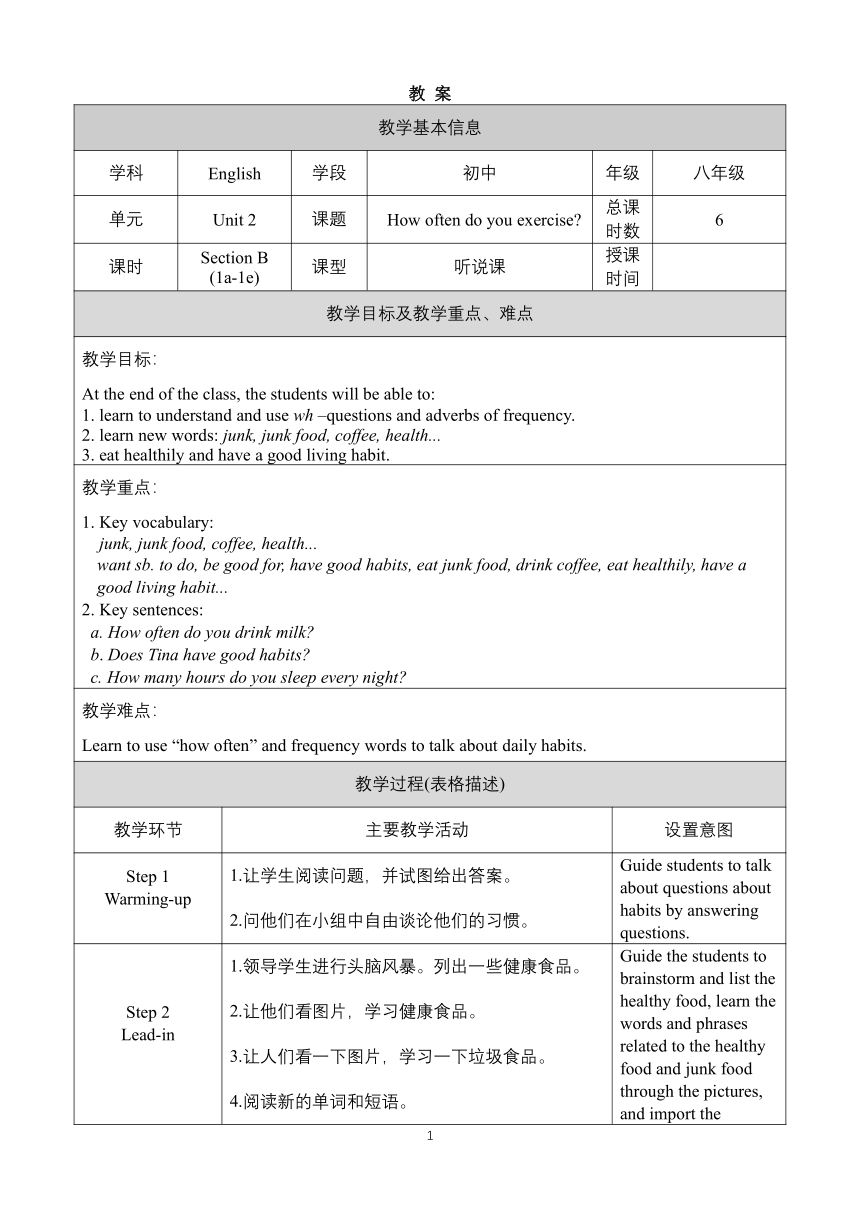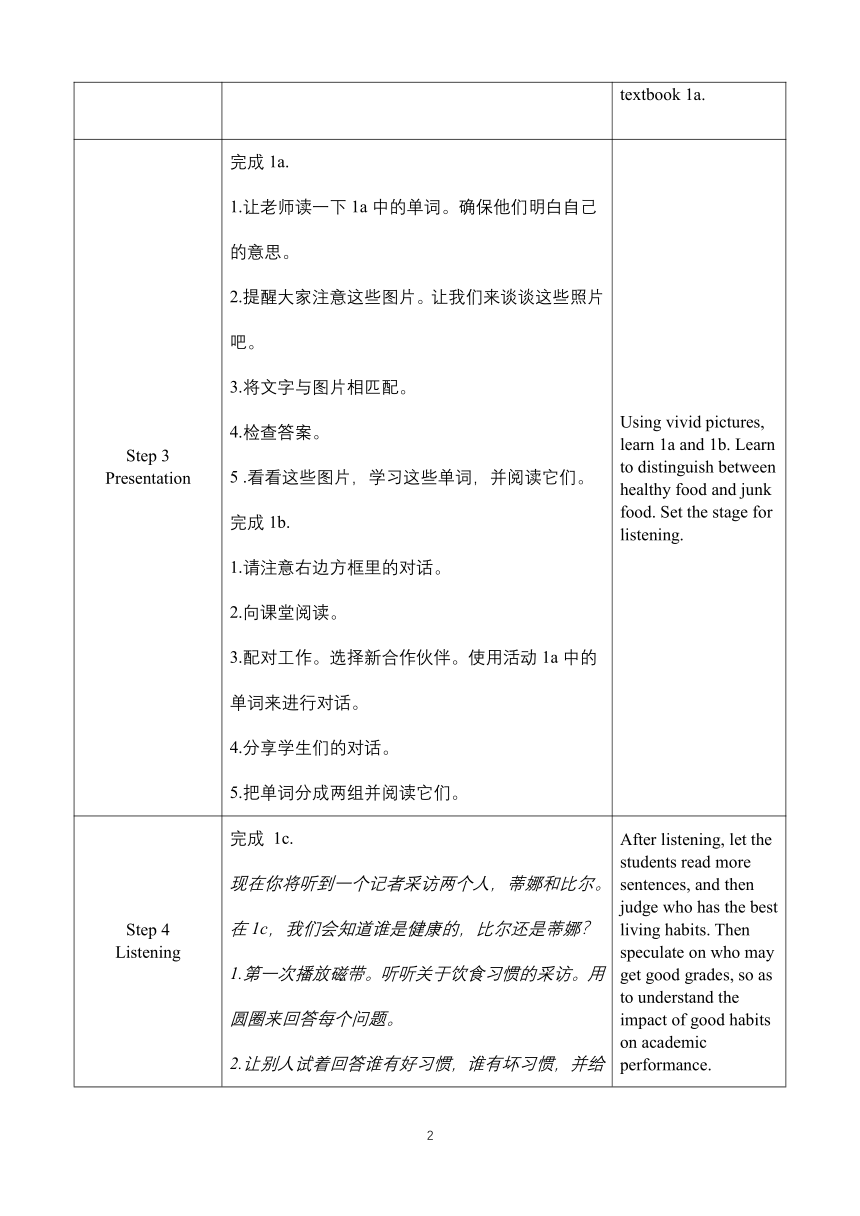人教版八年级上册英语 Unit 2 How often do you exercise Section B 1a-1e教案(表格式)
文档属性
| 名称 | 人教版八年级上册英语 Unit 2 How often do you exercise Section B 1a-1e教案(表格式) |  | |
| 格式 | docx | ||
| 文件大小 | 23.1KB | ||
| 资源类型 | 教案 | ||
| 版本资源 | 人教新目标(Go for it)版 | ||
| 科目 | 英语 | ||
| 更新时间 | 2024-09-16 23:15:47 | ||
图片预览


文档简介
教 案
教学基本信息
学科 English 学段 初中 年级 八年级
单元 Unit 2 课题 How often do you exercise 总课时数 6
课时 Section B (1a-1e) 课型 听说课 授课时间
教学目标及教学重点、难点
教学目标: At the end of the class, the students will be able to: 1. learn to understand and use wh –questions and adverbs of frequency. 2. learn new words: junk, junk food, coffee, health... 3. eat healthily and have a good living habit.
教学重点: 1. Key vocabulary: junk, junk food, coffee, health... want sb. to do, be good for, have good habits, eat junk food, drink coffee, eat healthily, have a good living habit... 2. Key sentences: a. How often do you drink milk b. Does Tina have good habits c. How many hours do you sleep every night
教学难点: Learn to use “how often” and frequency words to talk about daily habits.
教学过程(表格描述)
教学环节 主要教学活动 设置意图
Step 1 Warming-up 1.让学生阅读问题,并试图给出答案。 2.问他们在小组中自由谈论他们的习惯。 Guide students to talk about questions about habits by answering questions.
Step 2 Lead-in 1.领导学生进行头脑风暴。列出一些健康食品。 2.让他们看图片,学习健康食品。 3.让人们看一下图片,学习一下垃圾食品。 4.阅读新的单词和短语。 Guide the students to brainstorm and list the healthy food, learn the words and phrases related to the healthy food and junk food through the pictures, and import the textbook 1a.
Step 3 Presentation 完成1a. 1.让老师读一下1a中的单词。确保他们明白自己的意思。 2.提醒大家注意这些图片。让我们来谈谈这些照片吧。 3.将文字与图片相匹配。 4.检查答案。 5 .看看这些图片,学习这些单词,并阅读它们。 完成1b. 1.请注意右边方框里的对话。 2.向课堂阅读。 3.配对工作。选择新合作伙伴。使用活动1a中的单词来进行对话。 4.分享学生们的对话。 5.把单词分成两组并阅读它们。 Using vivid pictures, learn 1a and 1b. Learn to distinguish between healthy food and junk food. Set the stage for listening.
Step 4 Listening 完成 1c. 现在你将听到一个记者采访两个人,蒂娜和比尔。在1c,我们会知道谁是健康的,比尔还是蒂娜? 1.第一次播放磁带。听听关于饮食习惯的采访。用圆圈来回答每个问题。 2.让别人试着回答谁有好习惯,谁有坏习惯,并给出理由。 完成1d. 1.第二次播放磁带,然后让他再听一遍,然后在调查中填写空白。 2.在课堂上检查答案。 3.询问学生: Who has better eating habits Whose lifestyle is better Who can get better grades 4.让一些学生给出结果和原因。 After listening, let the students read more sentences, and then judge who has the best living habits. Then speculate on who may get good grades, so as to understand the impact of good habits on academic performance.
Step 5 Role-play 完成 1e. 学生A是记者。学生B是蒂娜或比尔。提问和回答问题。然后改变角色。 请老师成对工作,进行面试。 S1:How often do you exercise S2:I exercise every day. S1:And how often do you... 2.调用一组来在课堂上展示。 Solve the usage of words and key phrases in this class hour, and solve the difficult points in this class hour.
Step 6 Language points 1. 解释用法 want sb. to do, be good for, healthy. 2. 让学生读一下。 Solve the usage of words and key phrases in this class hour, and solve the difficult points in this class hour.
Step 7 Exercises 练习关键词、目标语言和关键句子。 By practicing the use of the word healthy, students can link their current study with the middle school entrance examination.
Step 8 中考链接 练习关键词healthy.的使用 By practicing the use of the word healthy, students can link their current study with the middle school entrance examination.
Step 9 Homework 在“我的习惯(好习惯和坏习惯)中 为这个标题写一篇短文。(不少于50个字。) The purpose of writing short essays is to practice the interview report learned in this unit, and to output the listening materials learned in this class hour.
板书设计 Unit 2 How often do you exercise Section B (1a-1e) want sb. to do, be good for, have good habits, eat junk food, eat healthily, have a good living habit. - How often do you drink milk - I drink milk every day. How many hours do you sleep every night
教学反思 Through the teaching of this unit, students are guided to understand good living habits and bad habits, so as to cultivate students' good habits. In this lesson, the teacher repeatedly emphasized the different forms of health, healthy, healthily, and the differences between be good for, be good at, be good with and be good to.
(
3
)
教学基本信息
学科 English 学段 初中 年级 八年级
单元 Unit 2 课题 How often do you exercise 总课时数 6
课时 Section B (1a-1e) 课型 听说课 授课时间
教学目标及教学重点、难点
教学目标: At the end of the class, the students will be able to: 1. learn to understand and use wh –questions and adverbs of frequency. 2. learn new words: junk, junk food, coffee, health... 3. eat healthily and have a good living habit.
教学重点: 1. Key vocabulary: junk, junk food, coffee, health... want sb. to do, be good for, have good habits, eat junk food, drink coffee, eat healthily, have a good living habit... 2. Key sentences: a. How often do you drink milk b. Does Tina have good habits c. How many hours do you sleep every night
教学难点: Learn to use “how often” and frequency words to talk about daily habits.
教学过程(表格描述)
教学环节 主要教学活动 设置意图
Step 1 Warming-up 1.让学生阅读问题,并试图给出答案。 2.问他们在小组中自由谈论他们的习惯。 Guide students to talk about questions about habits by answering questions.
Step 2 Lead-in 1.领导学生进行头脑风暴。列出一些健康食品。 2.让他们看图片,学习健康食品。 3.让人们看一下图片,学习一下垃圾食品。 4.阅读新的单词和短语。 Guide the students to brainstorm and list the healthy food, learn the words and phrases related to the healthy food and junk food through the pictures, and import the textbook 1a.
Step 3 Presentation 完成1a. 1.让老师读一下1a中的单词。确保他们明白自己的意思。 2.提醒大家注意这些图片。让我们来谈谈这些照片吧。 3.将文字与图片相匹配。 4.检查答案。 5 .看看这些图片,学习这些单词,并阅读它们。 完成1b. 1.请注意右边方框里的对话。 2.向课堂阅读。 3.配对工作。选择新合作伙伴。使用活动1a中的单词来进行对话。 4.分享学生们的对话。 5.把单词分成两组并阅读它们。 Using vivid pictures, learn 1a and 1b. Learn to distinguish between healthy food and junk food. Set the stage for listening.
Step 4 Listening 完成 1c. 现在你将听到一个记者采访两个人,蒂娜和比尔。在1c,我们会知道谁是健康的,比尔还是蒂娜? 1.第一次播放磁带。听听关于饮食习惯的采访。用圆圈来回答每个问题。 2.让别人试着回答谁有好习惯,谁有坏习惯,并给出理由。 完成1d. 1.第二次播放磁带,然后让他再听一遍,然后在调查中填写空白。 2.在课堂上检查答案。 3.询问学生: Who has better eating habits Whose lifestyle is better Who can get better grades 4.让一些学生给出结果和原因。 After listening, let the students read more sentences, and then judge who has the best living habits. Then speculate on who may get good grades, so as to understand the impact of good habits on academic performance.
Step 5 Role-play 完成 1e. 学生A是记者。学生B是蒂娜或比尔。提问和回答问题。然后改变角色。 请老师成对工作,进行面试。 S1:How often do you exercise S2:I exercise every day. S1:And how often do you... 2.调用一组来在课堂上展示。 Solve the usage of words and key phrases in this class hour, and solve the difficult points in this class hour.
Step 6 Language points 1. 解释用法 want sb. to do, be good for, healthy. 2. 让学生读一下。 Solve the usage of words and key phrases in this class hour, and solve the difficult points in this class hour.
Step 7 Exercises 练习关键词、目标语言和关键句子。 By practicing the use of the word healthy, students can link their current study with the middle school entrance examination.
Step 8 中考链接 练习关键词healthy.的使用 By practicing the use of the word healthy, students can link their current study with the middle school entrance examination.
Step 9 Homework 在“我的习惯(好习惯和坏习惯)中 为这个标题写一篇短文。(不少于50个字。) The purpose of writing short essays is to practice the interview report learned in this unit, and to output the listening materials learned in this class hour.
板书设计 Unit 2 How often do you exercise Section B (1a-1e) want sb. to do, be good for, have good habits, eat junk food, eat healthily, have a good living habit. - How often do you drink milk - I drink milk every day. How many hours do you sleep every night
教学反思 Through the teaching of this unit, students are guided to understand good living habits and bad habits, so as to cultivate students' good habits. In this lesson, the teacher repeatedly emphasized the different forms of health, healthy, healthily, and the differences between be good for, be good at, be good with and be good to.
(
3
)
同课章节目录
- Unit 1 Where did you go on vacation?
- Section A
- Section B
- Unit 2 How often do you exercise?
- Section A
- Section B
- Unit 3 I'm more outgoing than my sister.
- Section A
- Section B
- Unit 4 What's the best movie theater?
- Section A
- Section B
- Unit 5 Do you want to watch a game show?
- Section A
- Section B
- Unit 6 I'm going to study computer science.
- Section A
- Section B
- Unit 7 Will people have robots?
- Section A
- Section B
- Unit 8 How do you make a banana milk shake?
- Section A
- Section B
- Unit 9 Can you come to my party?
- Section A
- Section B
- Unit 10 If you go to the party, you'll have a grea
- Section A
- Section B
